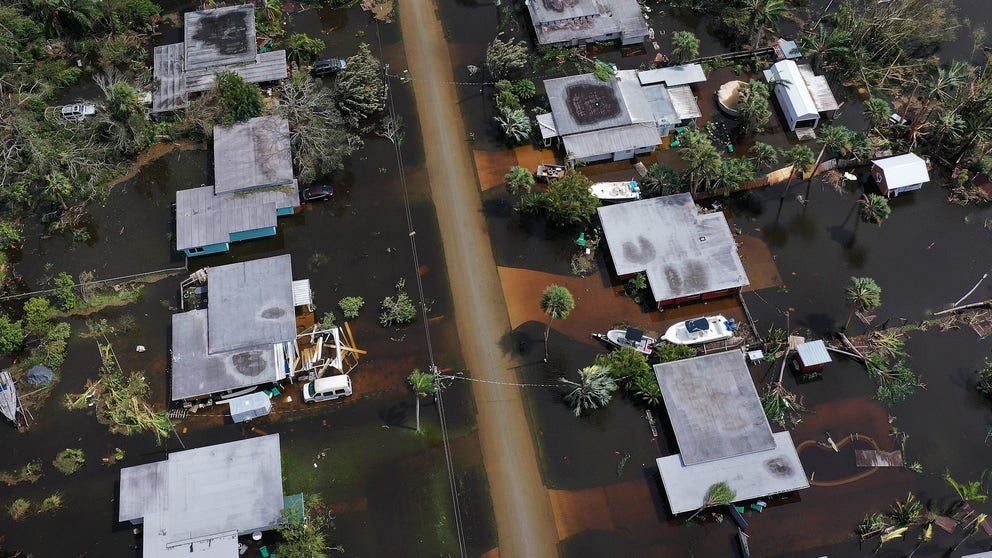Hurricane Ian by the numbers: The scope of the catastrophic damage
Ian crashed into Southwest Florida on Sept. 28, 2022, as a Category 4 hurricane with 150-mph winds.
Key lessons learned from Hurricane Ian 6 months later
FOX Weather Hurricane Specialist Bryan Norcross breaks down Hurricane Ian’s timeline and explains how messaging between officials and weather centers can improve for the next big storm.
Hurricane Ian was one of the most impactful storms in U.S. history after battering Southwest Florida last year.
Ian made landfall Sept. 28, 2022, in the Fort Myers area as a Category 4 hurricane. The ferocious 150-mph winds pushed ashore feet of water from the Gulf of Mexico that tore through homes and businesses along the coast.
The following day, Ian crossed the Florida Peninsula diagonally and dumped flooding rain on the interior and blew in storm surge along the opposite coast from where it made landfall.
Ian made a third and final U.S. landfall in South Carolina two days after slamming into Florida.
The scope of the disaster can be seen in these numbers, which reveal the magnitude of Hurricane Ian’s impact.
FEARING DEATH, PRAYING FOR A MIRACLE: SANIBEL ISLAND WOMAN SURVIVES IAN'S HISTORIC WRATH

Stedi Scuderi looks over her apartment after flood water inundated it when Hurricane Ian passed through the area on September 29, 2022 in Fort Myers, Florida.
(Joe Raedle / Getty Images)
More than 100 deaths
The death toll from Hurricane Ian climbed to more than 100, with search and rescue operations continuing for days after the storm hit.
Most of the fatalities were reported in Florida, specifically in Lee County. That’s where popular barrier islands like Pine Island and Sanibel Island were wrecked by storm surge and powerful wind as Ian came ashore, cutting them off from the mainland and complicating rescue operations.
At least five storm-related deaths were reported in North Carolina, and one was reported in Virginia.
According to the United Nations, three people died in Cuba as Hurricane Ian tore across the western tip of the island.
See the devastating scale of Ian's destruction in Florida
FOX Weather's Robert Ray explains the staggering levels of devastation left behind by Hurricane Ian along Florida's Gulf Coast.
Almost 2,500 rescues
Florida Gov. Ron DeSantis said in the days that followed Ian's landfall that almost 2,500 people were rescued as search-and-rescue teams went door-to-door, looking for survivors.
About 100,000 structures were searched, according to DeSantis.
MANY STILL MISSING IN FORT MYERS FOLLOWING IAN AS DEBRIS PILES COMPLICATE SEARCH OPERATIONS
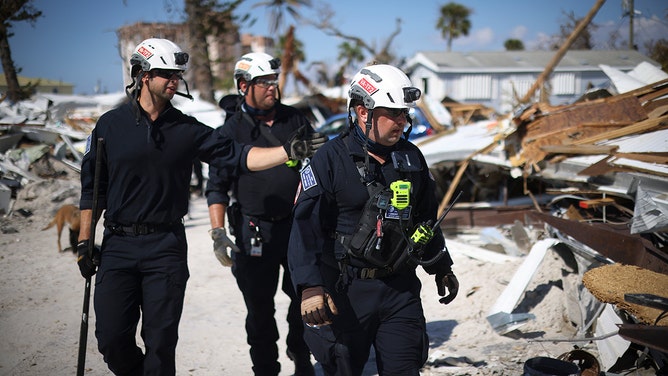
Members of Virginia Task Force 2 Urban Search and Rescue comb through the wreckage on Fort Myers Beach looking for victims of Hurricane Ian October 04, 2022 in Fort Myers Beach, Florida.
(Win McNamee / Getty Images)
At least 13 million power outages
Ian caused catastrophic damage to Florida’s power grid. In the immediate aftermath, outages climbed to more than 2.5 million in the state.
There was a steady improvement in that number in the week after Hurricane Ian hit as power crews were able to finally reach the most-devastated parts of the region.
Including the entire path of the storm, power outages during Ian likely added up to at least 13 million. Cuba experienced an island-wide blackout when Ian tore across the western side of the island. The Carolinas reported thousands of outages when Ian made its final landfall on Sept. 30.
Fort Myers family documents their cleanup process following Hurricane Ian
The Mannella family joined FOX Weather to talk about their cleanup process in the aftermath of Hurricane Ian.
4 landfalls
Hurricane Ian was being watched long before it made a run at the U.S.
It started as a tropical disturbance east of the Caribbean and was given a name once it reached tropical-storm status north of the so-called ABC islands near South America.
It became a hurricane as it turned north and took aim at the western tip of Cuba, where it made its first landfall Sept. 27.
Ian’s intensity grew as it exited Cuba and moved over the Gulf of Mexico and toward Florida.
The storm made its second overall landfall and first U.S. landfall Sept. 28 on Cayo Costa island off the coast of Southwest Florida. About 90 minutes later, Ian made a second U.S. landfall and third overall near Punta Gorda, Florida.
Ian weakened as it moved across the Florida Peninsula and exited the state Sept. 29. However, it regained hurricane strength in the Atlantic as it turned toward the Southeastern U.S.
The final landfall for Hurricane Ian happened on Sept. 30 near Georgetown, South Carolina. That marked the third U.S. landfall of the storm and fourth overall.
‘IT WAS HORRIFYING’: WATCH AS FLORIDA MAN RIDES OUT HURRICANE IAN IN HIS BOAT
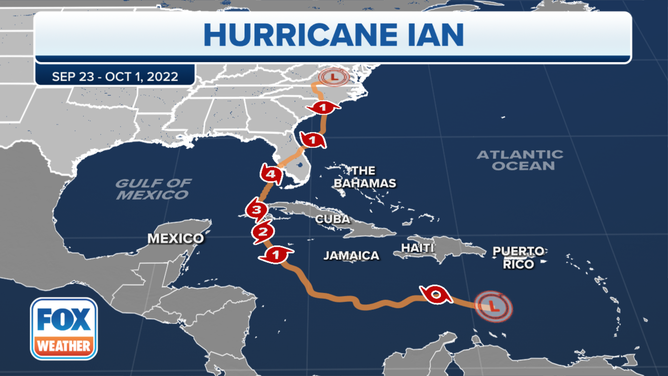
The track of Hurricane Ian.
(FOX Weather)
150-mph winds
While a post-storm analysis will determine the actual wind speeds that tore apart Southwest Florida, the National Hurricane Center estimated Hurricane Ian had winds of at least 150 mph when it made its first U.S. landfall on Cayo Costa island. About 90 minutes later, when Ian landed on mainland Florida, winds had decreased slightly to 145 mph, according to the NHC.
Ian had winds of 85 mph when it made its final landfall in South Carolina on Sept. 30.
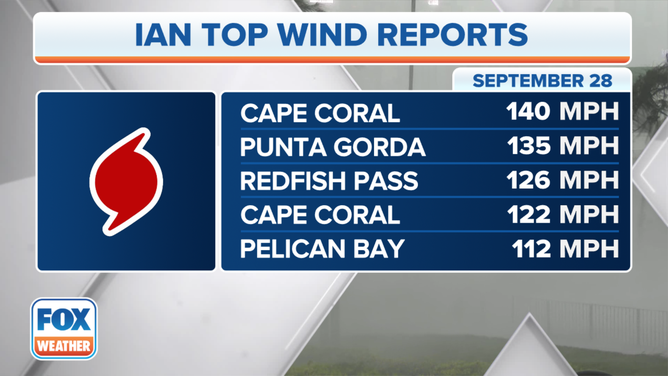
(FOX Weather)
10+ inches of rain over 3,500 square miles
An analysis by the Weather Prediction Center found that Hurricane Ian dumped 10 or more inches of rain across 3,500 square miles of Florida on Sept. 28, the day of landfall. That equates to a little more than 5% of the entire state.
Ian ranks as the third-highest coverage of 10-plus inches of rain in a 24-hour period from a tropical system since 2005, according to the WPC. Only Hurricane Harvey in 2017 outranks Ian.
IAN TOSSES BOATS AROUND LIKE ‘TINKERTOYS’ AT FORT MYERS MARINA
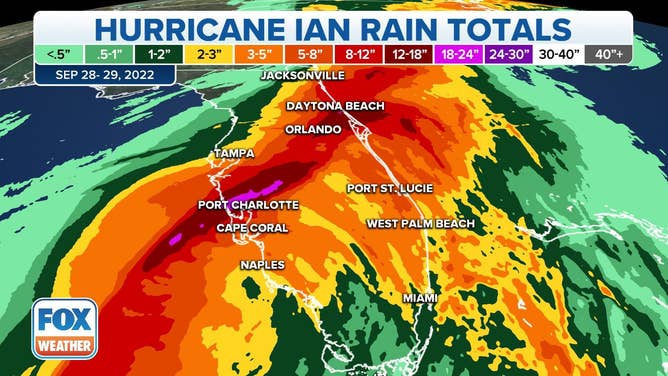
Total rainfall estimates for Hurricane Ian in Florida.
(FOX Weather)
At least 7 feet of storm surge
The NHC will conduct a post-storm analysis of storm surge to determine the actual height of the water pushed ashore by Hurricane Ian. In the meantime, we can use gauges that reported during the storm to get a rough idea of how high the water got.
The highest gauge reading known right now is at least 7.21 feet of storm surge in Fort Myers. That broke the previous record surge of 3.36 feet during Hurricane Gabrielle in 2001.
Records were also broken in Naples and Key West, where the surge reached at least 6.18 feet and 4.27 feet, respectively.
DeSantis said he received reports of at least 12 feet of storm surge, which seems possible given the forecast called for 12-18 feet of storm surge in the Fort Myers area.
IMAGES REVEAL THE PATH OF DESTRUCTION LEFT FROM HURRICANE IAN
Watch as water bursts through door of Naples building during Hurricane Ian
A couple from Tampa who had evacuated to Naples ahead of Hurricane Ian had first-hand experience with the storm's fury when water bursts through the door of the building they were staying in.

